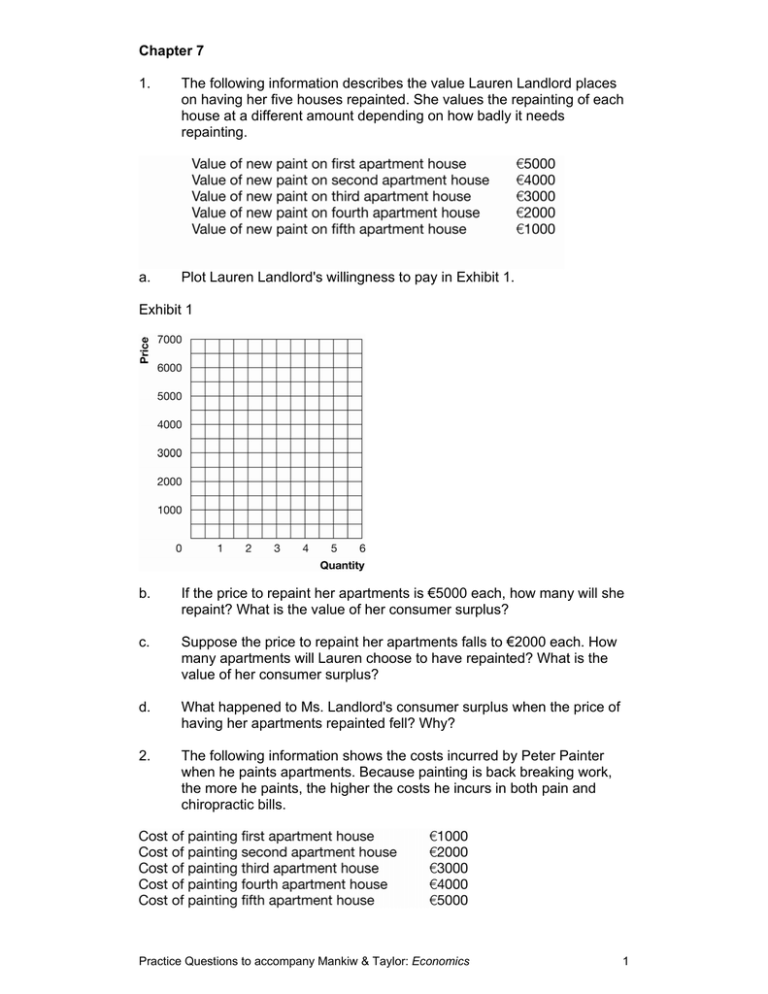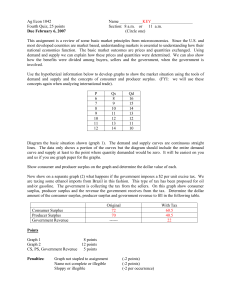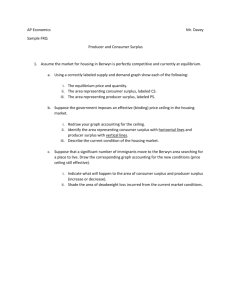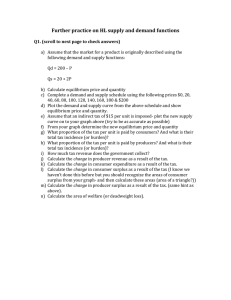Chapter 7 1. The following information describes the value Lauren Landlord places
advertisement

Chapter 7 1. The following information describes the value Lauren Landlord places on having her five houses repainted. She values the repainting of each house at a different amount depending on how badly it needs repainting. a. Plot Lauren Landlord's willingness to pay in Exhibit 1. Exhibit 1 b. If the price to repaint her apartments is €5000 each, how many will she repaint? What is the value of her consumer surplus? c. Suppose the price to repaint her apartments falls to €2000 each. How many apartments will Lauren choose to have repainted? What is the value of her consumer surplus? d. What happened to Ms. Landlord's consumer surplus when the price of having her apartments repainted fell? Why? 2. The following information shows the costs incurred by Peter Painter when he paints apartments. Because painting is back breaking work, the more he paints, the higher the costs he incurs in both pain and chiropractic bills. Practice Questions to accompany Mankiw & Taylor: Economics 1 a. Plot Peter Painter's cost in Exhibit 2. Exhibit 2 b. If the price of painting apartment houses is €2000 each, how many will he paint? What is the value of his producer surplus? c. Suppose the price to paint apartments rises to €4000 each. How many apartments will Peter choose to repaint? What is the value of his producer surplus? d. What happened to Mr. Painter's producer surplus when the price to paint apartments rose? Why? 3. Use the information about willingness to pay and cost from (1) and (2) above to answer the following questions. a. If a benevolent social planner sets the price for painting apartment houses at €5000, what is the value of consumer surplus? Producer surplus? Total surplus? b. If a benevolent social planner sets the price for painting apartment houses at €1000, what is the value of consumer surplus? Producer surplus? Total surplus? c. If the price for painting apartment houses is allowed to move to its free market equilibrium price of €3000, what is the value of consumer surplus, producer surplus, and total surplus in the market? How does total surplus in the free market compare to the total surplus generated by the social planner? Practice Questions to accompany Mankiw & Taylor: Economics 2 4. In Exhibit 3, plot the linear supply and demand curves for painting apartments implied by the information in questions (1) and (2) above (draw them so that they contact the vertical axis). Show consumer and producer surplus for the free market equilibrium price and quantity. Is this allocation of resources efficient? Why? Exhibit 3 5. Suppose Lauren Landlord has difficulty renting her dilapidated houses so she increases her willingness to pay for painting by €2000 per apartment. Plot Lauren’s new willingness to pay along with Peter's cost in Exhibit 4. If the equilibrium price rises to €4000, what is the value of consumer surplus, producer surplus, and total surplus? Show consumer and producer surplus on the graph. Compare your answer to the answer you found in 3 (c) above. Exhibit 4 Practice Questions to accompany Mankiw & Taylor: Economics 3









